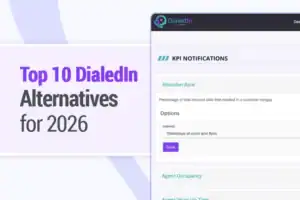With the growing importance of self-service support as a mean of engaging with customers, firms are seeking ways of developing advanced customer support to create customer satisfaction. Conversational AI is on the forefront of this change through enabling business organizations to offer better and natural-like interface. But what is Conversational AI, and how it can be implemented?
Here is a closer look at this revolutionary technology, as well as its many uses and benefits.
What Is Conversational AI ?
Conversational AI refers to dialogic technologies that help machines replicate actual conversations with end-users. In contrast with static script based chatbots, conversational AI depends on over Natural Language Processing, Machine Learning and other related technologies that enable the chatbot to understand human language as well as part with contextually. This capability enables it end to end managing of interactions, intent understanding and its response, and makes it provide more natural and engaging responses.
Conversational AI definition can be viewed in the attempts to minimize the people –assistant gap. It allows the user to interact with the application, a website or a device through natural language voice or text. From simple Information providing to problem Solving to recommendation and task-provide-and-follow-up, Conversational AI is disrupting the business operations of organizations and their customer interfaces.
How Conversational AI Works
Understanding how Conversational AI functions requires a closer look at the underlying technologies that power it. Here’s a breakdown of the key components:
Natural Language Processing (NLP)
Conversational AI starts with NLP. This is the measure of the AI system’s capability to learn natural language as spoken and written by humans, with all the prosodic, contextual and grammatical implications. NLP takes as input one or several sentences or words or speech and divides it into linguistic components such as words, phrases and sentences and then makes an analysis using the individual elements of the input. This involves several sub-processes:
- Tokenization: Splitting text into individual words or tokens.
- Part-of-Speech Tagging: Identifying the grammatical roles of each word in a sentence.
- Named Entity Recognition (NER): Detecting entities like names, dates, and locations within the text.
- Sentiment Analysis: Determining the sentiment or emotional tone behind the text.
By understanding these aspects, NLP enables Conversational AI to comprehend user inputs more accurately and provide relevant responses.
Machine Learning (ML)
Machine Learning plays an important role in enriching the features of Conversational AI. Closely monitoring the past data and dealing with previous conversation data the AI system will be always improving the accuracy. Machine learning enables the AI to pattern, to predict and to learn the new behavioral patterns that users will follow/develop in the future so there is no need for programming at specific cases. It also allows Conversational AI to continuously learn and become better at handling many forms of interactions and discussions at any given time.
Speech Recognition
For voice-based AI systems, Speech Recognition technology is critical. It translates spoken language into text, enabling the AI to process and comprehend verbal inputs. This process involves several steps, including:
- Acoustic Modeling: Mapping audio signals to phonetic units.
- Language Modeling: Predicting the likelihood of word sequences.
- Decoding: Converting the processed audio into readable text.
After the spoken words are transcribed into text, NLP processes the input, allowing the AI to produce an appropriate response. This procedure occurs in real-time, making sure that voice-based Conversational AI tools are prompt and efficient.
Dialogue Management
Dialogue Management is involved in determining how the conversation will continue and if it runs smoothly. It scans for conversation history, context and the users’ preferences in order to find the most appropriate responses whenever needed. This is crucial for maintaining topics and creating sense making prompts, especially where an AI is responding to conversational trails as seen in multiple turn conversations.
Response Generation
Eventually, the AI formulates a response based on its comprehension of the user’s input. This response can take the form of text, voice, or even an action (such as making an appointment or completing a purchase). The quality of the response is a critical factor in creating a human-like interaction.
“Conversational AI offers a unique opportunity for businesses to scale their operations while maintaining a high standard of customer service. With NobelBiz’s innovative solutions, companies can deliver consistent, high-quality interactions that meet the evolving needs of today’s consumers.” – Christian Montes Executive Vice President Client Operations
Conversational AI Examples
Conversational AI is already making a significant impact across various industries. Here are some real-world examples of its application:
Virtual Assistants
Popular virtual assistants like Siri, Alexa, and Google Assistant are prime examples of Conversational AI in action. They help users perform tasks, answer queries, and manage their daily activities through natural, voice-driven interactions.
Customer Service Chatbots
Many businesses deploy AI-powered chatbots on their websites and social media platforms to handle customer inquiries, provide product recommendations, and assist with transactions. These bots can handle a wide range of tasks, from answering FAQs to processing orders, providing a seamless customer experience.
Voice Assistants in Call Centers
In contact centers, voice AI tools assist human agents by providing real-time suggestions, automating routine tasks, and even handling entire conversations. This not only improves efficiency but also enhances the overall quality of customer service.
Related Article
Brayan Carpio
‘The technology aspect of NobelBiz stood out compared to the competition, and also the great team! All the way from onboarding to support to troubleshooting has been great throughout this journey!’
Benefits of Conversational AI
Business conversations handled by Conversational AI have numerous advantages that go beyond customer experience enhancement in business processes. Here’s how it can transform your business:Here’s how it can transform your business:
Enhance Your Customer Experience
Another benefit of Conversational AI is the availability of the service, which allows customers to get the necessary help immediately, regardless of the time of day or night. Tasks may range from responding to a basic question or processing a complicated problem and once the customer interacts with the Conversational AI, they can be sure they will receive the right help within no time and without having to deal with a real person. Further, it can make a difference in conversation by recalling a client’s preference, and thereby provide better customer relations.
Improve Agent Efficiency and Productivity
Using automated solutions for ordinary work and primary calls, Conversational AI relieves employees while considering difficult and valuable responsibilities. This not only helps in less burden on the support team but also increases the efficiency to a great extent. Call center agents are positioned to act on more intellectually demanding and emotionally sensitive work like dealing with escalated cases or giving a customized solution which results in improved customer satisfaction.
Make Communication Accessible
Conversational AI is designed to be inclusive, with support for multiple languages, dialects, and even different communication styles. It makes the reach of business to everyone easier since it eradicates any barrier such as language, or disability so that anyone can receive the information and services they require. Besides, voice-based AI can help the disabled because in case of communication with them most people are not ready to use touch but voice is more reliable.
Scale Operations with Ease
As your business expands, the need for customer interactions increases. Conversational AI can easily scale to manage larger volumes of interactions without sacrificing quality or response times. Whether you are a small business undergoing swift growth or a large enterprise with a global clientele, Conversational AI can meet your demands and ensure consistent service delivery.
Get Better Data Insights and Analytics
Every engagement with Conversational AI produces valuable data that can be analyzed for deeper understanding of customer behavior, preferences, and challenges. By using these insights, businesses can make knowledgeable decisions to enhance their products, services, and customer engagement strategies. What’s more, AI-driven analytics can reveal trends and patterns that may not be visible through conventional analysis methods, providing you with a competitive advantage in the market.
How to Use Conversational AI in Your Business
The versatility of Conversational AI makes it suitable for businesses of all sizes, from small startups to large enterprises. Here’s how you can leverage this technology based on the scale of your operations:
How to Use Conversational AI in a Small Business
Small businesses often have limited resources, making it challenging to provide extensive customer support. Conversational AI can bridge this gap by automating several key functions:
- Automate Customer Support: Deploy AI-powered chatbots to handle common inquiries and provide instant responses, reducing the need for a large support team.
- Schedule Appointments: Use AI to manage appointment bookings, ensuring that customers can schedule services without waiting for human intervention.
- Generate and Qualify Leads: Conversational AI can engage potential customers, gather information, and qualify leads before passing them to your sales team, streamlining the lead generation process.
How to Use Conversational AI in a Medium-sized Business
Medium-sized businesses can benefit from Conversational AI by enhancing both customer-facing and internal operations:
- Assist Sales and Customer Support Teams: Provide real-time support and suggestions to your teams, improving customer interactions and helping close more deals.
- Create Marketing Campaigns: Use AI to personalize marketing messages and automate campaign delivery, ensuring that your marketing efforts are both efficient and effective.
- Communicate and Collaborate Internally: Deploy AI-powered tools to facilitate internal communication and collaboration, making team workflows more efficient and reducing the chances of miscommunication.
How to Use Conversational AI in Enterprises
For large enterprises, Conversational AI can be integrated into various complex systems and processes, enhancing efficiency and scalability:
- Integrate Enterprise Resource Planning (ERP): Enhance your ERP systems with AI to enable smarter decision-making and automated processes that improve overall operational efficiency.
- Recruit Talent and Support Human Resources: AI can streamline the recruitment process by screening resumes, scheduling interviews, and managing HR inquiries, saving time and resources.
- Create Virtual Assistants for Different Departments: Develop AI assistants tailored to the specific needs of various departments, from IT to finance, to improve operational efficiency and provide specialized support.
Get More from Customer Conversations
As businesses increasingly rely on digital interactions, the ability to scale and optimize these conversations becomes crucial. Conversational AI is not just a tool for improving customer service; it’s a powerful asset for driving business growth, improving efficiency, and gaining deeper insights into customer behavior.
Scale Up with Contact Center AI
Integrating Conversational AI into your contact center operations is an investment in the future of your business. With advanced solutions like NobelBiz Omni+ and Balto AI, you can elevate your contact center’s capabilities, ensuring that you deliver exceptional customer experiences at scale. These tools provide real-time guidance, automate routine tasks, and offer valuable analytics, helping you stay ahead in an increasingly competitive market.
By leveraging the power of Conversational AI, you can transform how your business interacts with customers

Michael McGuire is a contact center industry expert with almost two decades of experience in the space. His experience includes roles as Director of Contact Center Digital Transformation at NobelBiz, and as Director of Operations at FLS Connect, managing multiple call centers. As President of Anomaly Squared and Targeted Metrics, Michael successfully transitioned companies into remote operations and significantly boosted revenues. With a strong background in customer service, leadership, strategic planning, and operations management, Michael excels in driving growth and innovation in the call center space.
Mike is also a proud Board Member for R.E.A.C.H Trade Group, promoting consumer protection and satisfaction and Co-host of the Off Skripted Podcast – a show about Life, Call Centers and everything in between.






